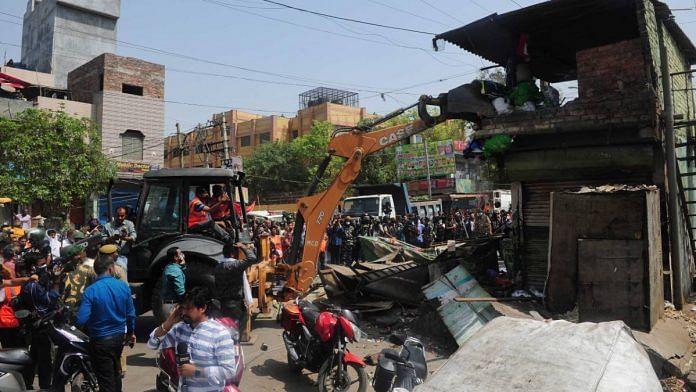New Delhi: Last month, a new electronic system called ‘FASTER’ was launched in order to electronically communicate the Supreme Court’s bail orders to jail authorities and trial courts. At the time, Chief Justice of India N.V. Ramana had conceded that even in the modern era of technology, courts were looking at the “skies for pigeons to deliver their orders”.
The system was introduced after the top court acknowledged the problem of delayed transmission of its orders, particularly in criminal cases. The issue gained attention after there was inexplicable delay on the part of Indore jail authorities to release stand-up comedian Munawar Faruqui, even after the SC had granted him bail.
This Wednesday, the North Delhi Municipal Corporation (colloquially known as North MCD) carried on with its demolition drive in Jahangirpuri, despite an SC order directing it to maintain the status quo, for which it has faced heavy criticism.
Bulldozers razed several shops, temporary structures, parts of houses as well as the external gate of a mosque in the locality, just four days after it witnessed a communal flare-up during a Hanuman Jayanti procession, leading to stone pelting and use of arms, leaving at least nine people injured.
But did a delay in transmission of SC’s orders lead to this?
According to senior advocate Dushyant Dave — who argued one of the petitions challenging the demolition drive in SC — the bulldozers reached Jahangirpuri at 9 am Wednesday, even though a notice issued by the North MCD the previous day had fixed 2 pm as the time for the drive to begin.
A bench led by CJI Ramana had issued the status quo order at 11 am the same day, after Dave sought judicial intervention to stop the demolition exercise. A status quo order entails that whatever action has been taken should be put in abeyance.
Soon after the demolition drive began, advocate M.R. Shamshad — counsel for the petitioner who moved court against the action Wednesday — sent a WhatsApp message to North MCD Mayor Raja Iqbal Singh, informing him about the court’s status quo order. Additionally, an email was sent at 11.20 am to the mayor, Delhi Police Commissioner Rakesh Asthana and Delhi Chief Secretary Naresh Kumar.
However, the demolition continued, with the authorities claiming they were not in possession of a written court order. This led Dave to mention the matter again before the CJI’s bench at 12.15 pm. Pained at approaching the court a second time, he complained that the authorities had refused to pay heed to the court’s order and the demolition was still on.
On the senior advocate’s request, the bench then asked the registrar to inform the authorities about the order. It was only then that the demolition was halted.
Lawyers representing the petitioners insisted that the court order was well-publicised on television channels and the North MCD was not required to wait for a written order to stop its action.
In this backdrop, ThePrint explains the procedure that is followed to communicate the SC’s orders to parties involved in litigation.
Also Read: ‘Can’t afford to take risks’: Why AAP leaders have been avoiding Jahangirpuri since riot
The role of the court master
According to senior officers of the SC registry, the court master is responsible for uploading the day’s “record of proceedings” or “daily orders” of a particular court on the official website of the SC. Once the orders are fed into the system, they are then released for physical disbursal through the appropriate judicial branch of the top court.
“A court master is responsible for taking down records of proceedings. Usually, orders dictated in the first half of the day or the pre-lunch sitting are finalised during the lunch hour between 1 and 2 pm. The orders given out in the second half get ready only after 4 pm,” one of the officers explained.
Unless a particular order requires the judges’ approval, the court master uploads all of them during the day or before the day ends. “Judges usually do not sign daily records of proceedings. Therefore, these daily orders are uploaded under the court master’s signatures and are then dispatched physically to the respondents,” another officer told ThePrint.
Matters of final disposal or cases where a final judgment is delivered are signed by judges. Such verdicts take some time to get ready before they are released officially on the website and to the parties.
In the case of daily orders, respondents usually receive the court order through Speed Post, which ordinarily takes two to three days. “These days, however, an email is also sent to them, provided the petitioner has provided one to the court,” one of the officers quoted above said.
Status quo order can be provided immediately
In the case of a status quo order, such as the one issued in the Jahangirpuri case, and if the petitioner asks for a copy immediately, it is provided, subject to the court’s direction.
“There are several cases where the petitioners have requested the court to release orders so that it can be communicated to the other side immediately. Many times, when interim orders do not reach the opposite side in time, the matter ends up becoming infructuous,” the officer said. “Therefore, in cases where litigants specifically request for the court to provide the order and if the court allows it, then the court master finalises that particular order out of turn, without waiting for the court to break into a lunch or calling it a day.”
There is also a system of a “dasti service”, under which the petitioner is allowed to take a court notice and serve it to the other side himself/herself. However, the same is done only in case of a notice and not an interim order, the officer said.
(Edited by Gitanjali Das)
Also Read: Riot-hit Khargone counts its losses, a torched PMAY house, broken dreams & dead animals



